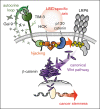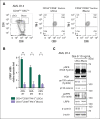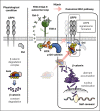TIM-3 signaling hijacks the canonical Wnt/β-catenin pathway to maintain cancer stemness in acute myeloid leukemia
- PMID: 36745103
- PMCID: PMC10196803
- DOI: 10.1182/bloodadvances.2022008405
TIM-3 signaling hijacks the canonical Wnt/β-catenin pathway to maintain cancer stemness in acute myeloid leukemia
Abstract
The activation of β-catenin plays critical roles in normal stem cell function, and, when aberrantly activated, the maintenance and enhancement of cancer stemness in many solid cancers. Aberrant β-catenin activation is also observed in acute myeloid leukemia (AML), and crucially contributes to self-renewal and propagation of leukemic stem cells (LSCs) regardless of mutations in contrast with such solid tumors. In this study, we showed that the AML-specific autocrine loop comprised of T-cell immunoglobulin mucin-3 (TIM-3) and its ligand, galectin-9 (Gal-9), drives the canonical Wnt pathway to stimulate self-renewal and propagation of LSCs, independent of Wnt ligands. Gal-9 ligation activates the cytoplasmic Src homology 2 domain of TIM-3 to recruit hematopoietic cell kinase (HCK), a Src family kinase highly expressed in LSCs but not in HSCs, and HCK phosphorylates p120-catenin to promote formation of the LDL receptor-related protein 6 (LRP6) signalosome, hijacking the canonical Wnt pathway. This TIM-3/HCK/p120-catenin axis is principally active in immature LSCs compared with TIM-3-expressed differentiated AML blasts and exhausted T cells. These data suggest that human AML LSCs constitutively activates β-catenin via autocrine TIM-3/HCK/p120-catenin signaling, and that molecules related to this signaling axis should be critical targets for selective eradication of LSCs without impairing normal HSCs.
© 2023 by The American Society of Hematology. Licensed under Creative Commons Attribution-NonCommercial-NoDerivatives 4.0 International (CC BY-NC-ND 4.0), permitting only noncommercial, nonderivative use with attribution. All other rights reserved.
Conflict of interest statement
Conflict-of-interest disclosure: The authors declare no competing financial interests.
Figures








Similar articles
-
[TIM-3 signaling hijacks the canonical Wnt/β-catenin pathway to maintain cancer stemness in human acute myeloid leukemia].Rinsho Ketsueki. 2023;64(6):547-552. doi: 10.11406/rinketsu.64.547. Rinsho Ketsueki. 2023. PMID: 37407480 Japanese.
-
A TIM-3/Gal-9 Autocrine Stimulatory Loop Drives Self-Renewal of Human Myeloid Leukemia Stem Cells and Leukemic Progression.Cell Stem Cell. 2015 Sep 3;17(3):341-52. doi: 10.1016/j.stem.2015.07.011. Epub 2015 Aug 13. Cell Stem Cell. 2015. PMID: 26279267
-
[A TIM-3/galectin-9 autocrine stimulatory loop drives self-renewal of human myeloid leukemia stem cells and leukemia progression].Rinsho Ketsueki. 2016 Apr;57(4):412-6. doi: 10.11406/rinketsu.57.412. Rinsho Ketsueki. 2016. PMID: 27169443 Japanese.
-
TIM-3 in normal and malignant hematopoiesis: Structure, function, and signaling pathways.Cancer Sci. 2021 Sep;112(9):3419-3426. doi: 10.1111/cas.15042. Epub 2021 Jul 14. Cancer Sci. 2021. PMID: 34159709 Free PMC article. Review.
-
Identification of TIM-3 as a Leukemic Stem Cell Surface Molecule in Primary Acute Myeloid Leukemia.Oncology. 2015;89 Suppl 1:28-32. doi: 10.1159/000431062. Epub 2015 Nov 10. Oncology. 2015. PMID: 26551150 Review.
Cited by
-
Wnt signaling pathways in biology and disease: mechanisms and therapeutic advances.Signal Transduct Target Ther. 2025 Apr 4;10(1):106. doi: 10.1038/s41392-025-02142-w. Signal Transduct Target Ther. 2025. PMID: 40180907 Free PMC article. Review.
-
"Galectin-9: A double-edged sword in Acute Myeloid Leukemia".Ann Hematol. 2025 Jun;104(6):3077-3090. doi: 10.1007/s00277-025-06387-x. Ann Hematol. 2025. PMID: 40341460 Free PMC article. Review.
-
KK2845, a PBD dimer-containing antibody-drug conjugate targeting TIM-3-expressing AML.Leukemia. 2025 Aug;39(8):1848-1856. doi: 10.1038/s41375-025-02642-2. Epub 2025 May 22. Leukemia. 2025. PMID: 40404985 Free PMC article.
-
Galectin-9, a pro-survival factor inducing immunosuppression, leukemic cell transformation and expansion.Mol Biol Rep. 2024 Apr 25;51(1):571. doi: 10.1007/s11033-024-09563-w. Mol Biol Rep. 2024. PMID: 38662155 Review.
-
TIM-3/Galectin-9 interaction and glutamine metabolism in AML cell lines, HL-60 and THP-1.BMC Cancer. 2024 Jan 24;24(1):125. doi: 10.1186/s12885-024-11898-3. BMC Cancer. 2024. PMID: 38267906 Free PMC article.
References
-
- Kikushige Y, Miyamoto T, Yuda J, et al. A TIM-3/Gal-9 autocrine stimulatory loop drives self-renewal of human myeloid leukemia stem cells and leukemic progression. Cell Stem Cell. 2015;17(3):341–352. - PubMed
-
- Kikushige Y, Shima T, Takayanagi Si, et al. TIM-3 is a promising target to selectively kill acute myeloid leukemia stem cells. Cell Stem Cell. 2010;7(6):708–717. - PubMed
-
- Monney L, Sabatos CA, Gaglia JL, et al. Th1-specific cell surface protein Tim-3 regulates macrophage activation and severity of an autoimmune disease. Nature. 2002;415(6871):536–541. - PubMed
Publication types
MeSH terms
Substances
LinkOut - more resources
Full Text Sources
Medical
Molecular Biology Databases
Research Materials
Miscellaneous

